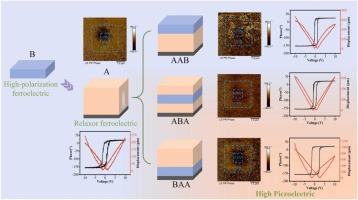Heterogeneous Layer Configuration Engineering for Enhanced Piezoelectric Performance of Bi(Fe0.95Mn0.03Ti0.02)O3/Bi0.5Na0.5TiO3-0.06BaTiO3 Composite Thin Films
IF 6.3
2区 材料科学
Q2 CHEMISTRY, PHYSICAL
引用次数: 0
Abstract
With the rapid development of smart electronics and micro-electro-mechanical systems (MEMS), lead-free piezoelectric thin films with both high piezoelectric activity and environmental stability have emerged as core materials, directly determining the performance upper limits of next-generation miniaturized devices. Heterostructured Bi(Fe0.95Mn0.03Ti0.02)O3/Bi0.5Na0.5TiO3-0.06BaTiO3 (denoted as B and A) multilayer thin films with distinct stacking sequences (BAA, ABA, AAB) were fabricated. The BAA structure exhibits superior performance, showing a high piezoelectric coefficient (d33⁎) of 98.1 pm/V—approximately 4.2 times that of the pure A thin film—along with a maximum polarization of 56.2 μC/cm² and a dielectric constant of 480 at 1 kHz. Moreover, the leakage current density is reduced by two orders of magnitude, and robust thermal stability of polarization is maintained over the temperature range of 25 - 200 °C. This work clarifies the mechanism by which heterolayer structure enhances piezoelectric properties, provides a strategy for developing high-performance lead-free piezoelectric thin films, and promotes their application in microelectronic devices, thereby driving technological and industrial progress in the field.

提高Bi(Fe0.95Mn0.03Ti0.02)O3/Bi0.5Na0.5TiO3-0.06BaTiO3复合薄膜压电性能的非均质层结构工程
随着智能电子和微机电系统(MEMS)的快速发展,具有高压电活性和环境稳定性的无铅压电薄膜已成为核心材料,直接决定了下一代小型化器件的性能上限。制备了具有不同堆叠顺序(BAA、ABA、AAB)的异质结构Bi(Fe0.95Mn0.03Ti0.02)O3/Bi0.5Na0.5TiO3-0.06BaTiO3(记为B和A)多层薄膜。BAA薄膜具有98.1 pm/ v的高压电系数(d33),约为纯a薄膜的4.2倍,最大极化为56.2 μC/cm²,在1 kHz时介电常数为480。此外,泄漏电流密度降低了两个数量级,并且在25 - 200°C的温度范围内保持了强大的极化热稳定性。本研究阐明了异质层结构提高压电性能的机理,为开发高性能无铅压电薄膜提供了策略,并促进了其在微电子器件中的应用,从而推动了该领域的技术和工业进步。
本文章由计算机程序翻译,如有差异,请以英文原文为准。
求助全文
约1分钟内获得全文
求助全文
来源期刊

Journal of Alloys and Compounds
工程技术-材料科学:综合
CiteScore
11.10
自引率
14.50%
发文量
5146
审稿时长
67 days
期刊介绍:
The Journal of Alloys and Compounds is intended to serve as an international medium for the publication of work on solid materials comprising compounds as well as alloys. Its great strength lies in the diversity of discipline which it encompasses, drawing together results from materials science, solid-state chemistry and physics.
 求助内容:
求助内容: 应助结果提醒方式:
应助结果提醒方式:


